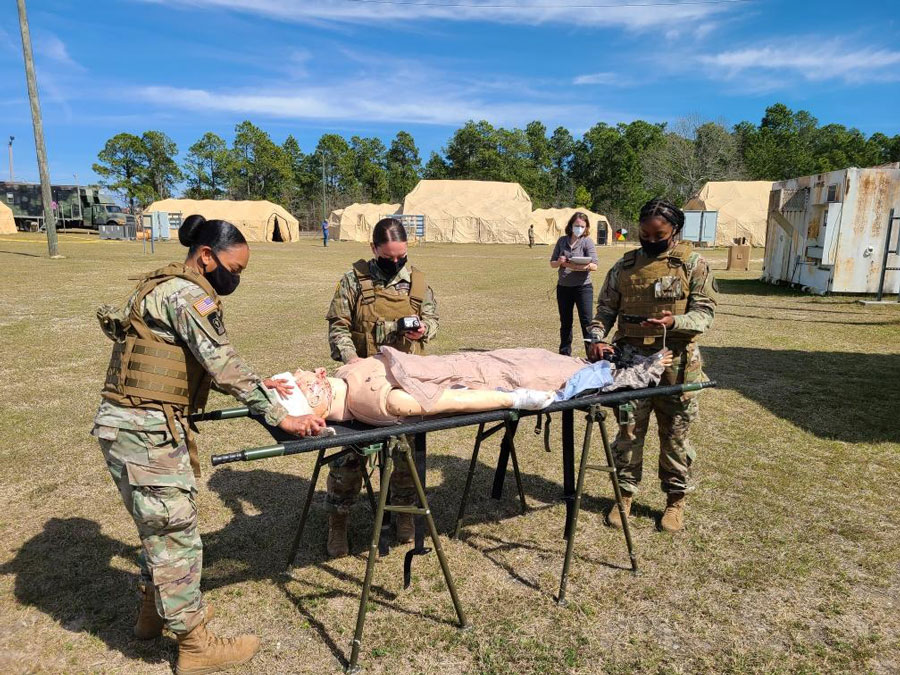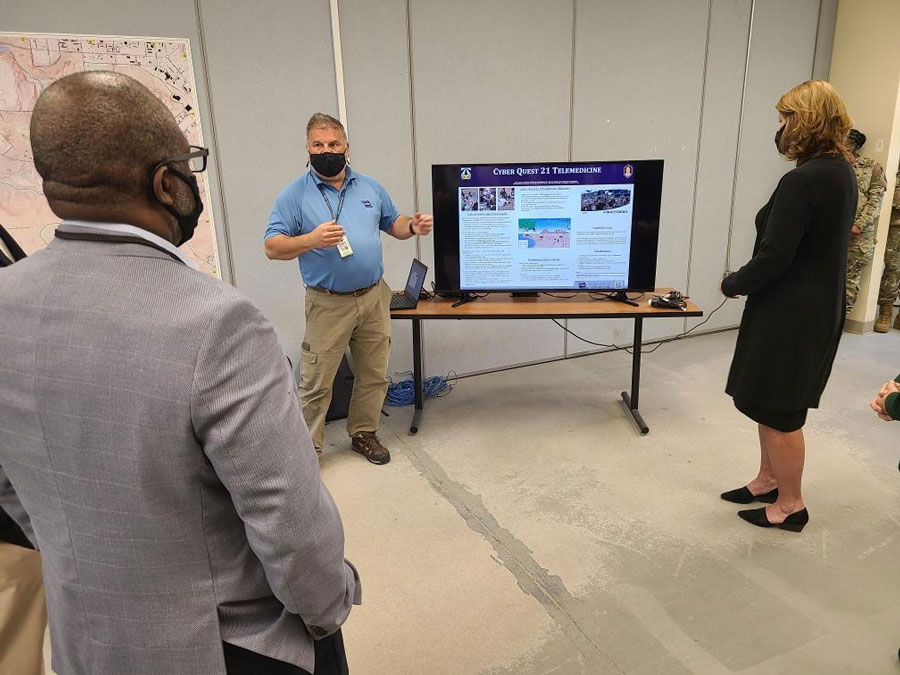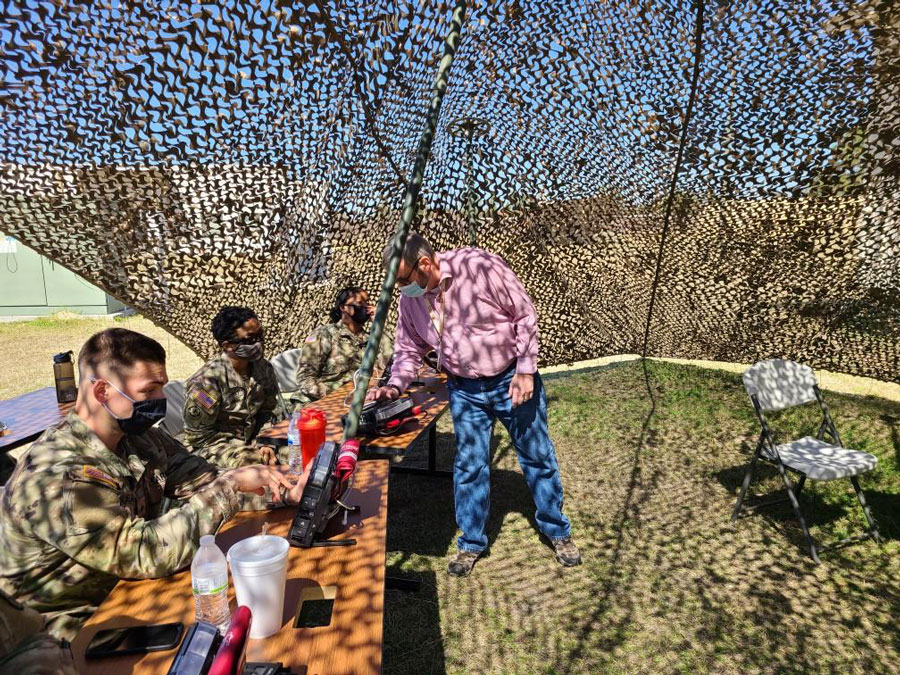Team TATRC Hits the Road in Support of Cyber Quest 21
March 31, 2021 | Download PDF
TATRC deployed seven representatives from multiple divisions within our organization to participate in this year’s Cyber Quest 21 (CQ21) at Fort Gordon in March. TATRC personnel coordinated with the CQ21 planners to synchronize the simulated casualty scenario within the CQ21 exercise One Semi-Automated Forces (OneSAF) computer simulation program, which was being conducted on-site at Fort Gordon in Augusta, GA. Mr. Carl Manemeit, Deputy Division Chief for the Medical Modeling Simulation, Informatics, and Visualization (MMSIV) team; Mr. James Beach, Project Manager; Mr. Larry Markins, Network Engineer, MMSIV; Ms. Christen Phillips, SIM Engineer, MMSIV; Mr. Edward Kensinger, Senior Project Manager, Digital Health Innovation Center (DHIC); Mr. Marvin Cole, DHIC; and Mr. John Small, DHIC were all on hand to support this annual event.

CQ21 was hosted by the Army Futures Command and the Cyber Center of Excellence to showcase and demonstrate emerging cyber, electronic warfare, intelligence and networking technologies. The Cyber Battle Lab was tasked to identify technology solutions to accelerate modernization and align with capability gaps of addressing the Army Multi-Domain Operation in Cyber, Signal and Electronic Warfare. This year’s event linked operational units conducting operational maneuver exercises under the Army Expeditionary Warrior Experiments (AEWE) held at Fort Benning. AEWE is a live-prototype assessment for Soldier and small-unit modernization that included live-fire and force-on-force experiments on the latest technologies at the squad and platoon level. CQ21 and AEWE were linked through the OneSAF which is a computer-generated forces simulation that provides entity-level models and behaviors through the tactical network.

As the OneSAF computer simulation initiated the battle from Fort Gordon under CQ21, the Army units at AEWE conducted their maneuvers for the reconnaissance, defense, and counter attack missions. When the simulated casualties occurred, TATRC personnel would stage simulation mannequins (MedSIM and Trauma FX) with combat wounds for medics at Fort Gordon to treat and assess. TATRC’s objective was to characterize bandwidth and network security bi-directional impacts of virtual health capabilities operating on a Brigade Tactical Radio Network and obtain human factors feedback from test participations utilizing virtual health capabilities during the command post exercise in minimally compressed prolonged field care scenarios.
TATRC’s objective for CQ21 was to conceptually demonstrate the use of telemedicine systems on tactical networks from simulated medical casualties in an operational environment at the point of injury, as well as collect data on the functionality, feasibility, and usability of the systems; and provide usable data to advanced developers and transition program managers on further development of the systems being researched.
Additionally, TATRC evaluated capabilities to provide the front line medic the ability to reach out and touch a specialized physician through telemedicine. TATRC conducted simulated casualty scenarios with a variety of medical personnel, to provide user feedback and recommendations on the point of care patient monitoring capabilities that can provide knowledge based telemedicine data through a tactical cloud to a medical provider in the rear. The new technologies identified to conceptually demonstrate tele-mentoring, and to close the capability gaps in cyberspace operations, were the U.S. Air Force Research Laboratory’s Battlefield Assisted Trauma Distributed Observation Kit (BATDOK), Remote Diagnostic Technologies’ Tempus Pro and Corsium Suite, and Aviation and Missile Center S3I’s Micro-Medical Data Cloud (MMDC) dashboard. The basic OV-1 concept, point of care patient monitoring devices; BATDOK and Tempus Pro, would make a call and transmit medical data, imagery, VOIP over tactical radios to a mobile PacStar server with the MMDC installed. Then a medical provider would receive the call and use the web browser over the internet to view the medical data and imagery, and have a VOIP conversation with the front line medic.

TATRC successfully connected the front line medical personnel at Fort Gordon, GA with surgeons at the Brigade HQ. The assessment and overall feedback from front line medics and medical providers was that the concept demonstration of these technologies was a complete success and highly recommend this for further advanced development and transition to a program of record.
This tactical telemedicine capability is a potential solution to provide front line medics with a valuable method to reach back and request assistance on patients that may be above their skill level in emergent or prolonged field care. The key success is increasing survivability rates and reducing non-urgent evacuations during Multi-Domain Operations with peer adversaries or in possible austere environments. It also fills critical operational medicine gaps identified by the Surgeons of the 75th Ranger Regiment and 160th SOAR and SOCOM in air-to-ground / ground-to-air medical information exchange during CASEVAC missions.
This three week event included setting up a local network that integrated with the CQ21 network, testing and validating telemedicine devices communicated through the network from the point of care to the Brigade Surgeon at the Tactical Operations Command, training the medical personnel on the medical devices and capabilities, execution of simulated combat casualty scenarios, and then a demonstration and presentation for Distinguished Visitors. The Distinguished Visitors included: Major General Neil Hersey, Commanding General, Cyber Center of Excellence and Brigadier General Miles Brown, Deputy Director, Futures and Concept Center.
TATRC’s MMSIV and DHIC staff were pleased to be involved in this exercise as it proved extremely beneficial for further testing and evaluation opportunities.
This article was published in the July 2021 issue of the TATRC Times.